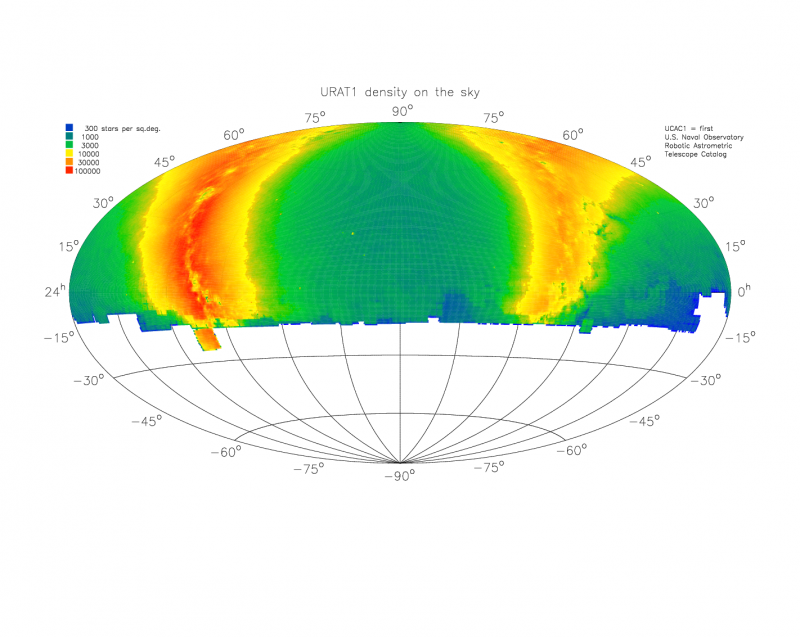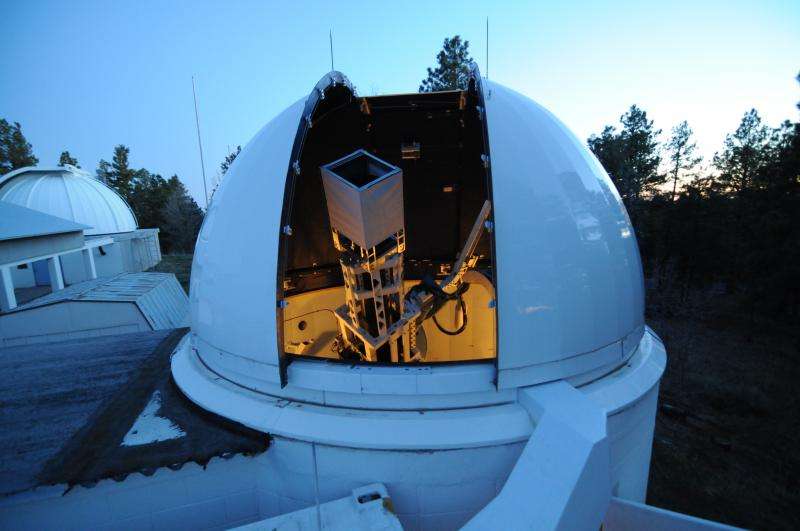USNO releases first version of newest star catalog

The United States Naval Observatory (USNO) has released the First Edition of its USNO Robotic Astrometric Telescope star catalog, URAT1. This catalog is the follow-on to the Observatory's previous USNO CCD Astrograph Catalog (UCAC4). The new catalog contains positional data on about 228 million stars with a magnitude range of 3.0 to 18.5 for a bandpass of 680 to 750 nanometers between declinations of +89.5 degrees and -15 degrees. Longer integration times and more sensitive, backside CCDs allowed for a substantial increase in limiting magnitude, resulting in a nearly 4-fold increase in the average number of stars per square degree as compared to UCAC.
URAT1 is supplemented by preliminary proper motions derived exclusively from 2-epoch URAT1 and Two Micron All Sky Survey (2MASS) data (at around epoch 2000) resulting in proper motion errors of typically 5 to 8 milliarcseconds (mas)/year. Photometry from 2MASS and the American Association of Variable Star Observers Photometric All-Sky Survey (APASS) is added for stars in common with URAT1.
The catalog was created using the same "Red Lens" used in the preceding UCAC catalogs; however, the lens was installed in a completely re-designed tube assembly fitted with a new, state-of-the-art large-format charge-coupled device (CCD) camera. This new camera consists of an array of four of the world's largest monolithic CCD detectors, each of which has 10,560 x 10,560 x 9-micron pixels. This array is cooled by liquid nitrogen and forms a large-scale focal plane that covers about 28 square degrees of the sky in a single image. The telescope, currently installed at the U.S. Naval Observatory Flagstaff Station (NOFS), has been designed to run autonomously with minimal human intervention.
In April, 2012 URAT began to systematically image the sky every clear night for a period of just over two years. Over 65,000 individual images were exposed during this time. Each individual exposure contains about 1 gigabyte of data.

Astronomers measure the sky in terms of angular degrees, minutes, and seconds of arc. The apparent size of the disc of the full Moon is approximately 30 arcminutes, or one-half of a degree. The apparent size of the disc of Mars at its most favorable oppositions is just over 25 arcseconds, slightly less than one-half of an arcminute. One arcsecond is the apparent size that a U.S. penny coin would appear if it were viewed from a distance of about 2.4 miles (3.9 kilometers).
The positions of the 3rd to 18.5th magnitude stars in the URAT1 are known to within an error of 5 to 30 milliarcseconds ("mas," or thousandths of a second of arc), which would be equivalent to the width of the "I" in the word "LIBERTY" on our penny about 6,000 feet (2 kilometers) away!
URAT1 will be available to users through the astrometric catalog server at the Strasbourg Astronomical Data Center (CDS, http://vizier.u-strasbg.fr/viz-bin/VizieR?-source=I/329) as Catalog I/329.
Current plans call for a second URAT2 data release in about a year, which will include 3+ years of operations, proper motions and parallaxes (of nearby stars) derived from URAT data.
Provided by USNO




















